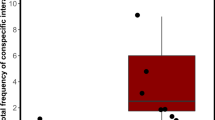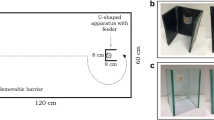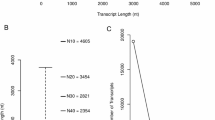Fish androgens may start to surge only when there seems to be a good chance of winning a contest.
Abstract

Androgens are the principal sex steroids controlling reproduction and aggression in male fish1, but their production can also be affected by social interactions2,3. Here we show that androgen concentrations are not significantly increased in cichlid fish (Oreochromis mossambicus) that are fighting their own image in a mirror, despite their aggressive behaviour towards the virtual intruder. Our results indicate that the hormonal response normally triggered in male contests is not induced under these circumstances by the act of fighting itself, and that it may therefore depend on some indicator of relative fighting ability that cannot be delivered by a mirror-image challenger.
This is a preview of subscription content, access via your institution
Access options
Subscribe to this journal
Receive 51 print issues and online access
$199.00 per year
only $3.90 per issue
Buy this article
- Purchase on Springer Link
- Instant access to full article PDF
Prices may be subject to local taxes which are calculated during checkout

Similar content being viewed by others
References
Borg, B. Comp. Biochem. Physiol. C 109, 219–245 (1994).
Oliveira, R. F. Adv. Study Behav. 34, 165–239 (2004).
Wingfield, J. C., Hegner, R. E., Dufty, A. M. & Ball, G. F. Am. Nat. 136, 829–846 (1990).
Rowland, W. J. Environ. Biol. Fish. 56, 285–305 (1999).
Oliveira, R. F., Almada, V. C. & Canário, A. V. M. Horm. Behav. 30, 2–12 (1996).
Martin, P. & Bateson, P. Measuring Behaviour: An Introductory Guide (Cambridge Univ. Press, Cambridge, 1993).
Hirschenhauser, K., Taborsky, M., Oliveira, T., Canário, A. V. M. & Oliveira, R. F. Anim. Behav. 68, 741–750 (2004).
Oliveira, R. F., Lopes, M., Carneiro, L. A. & Canário, A. V. M. Nature 409, 475 (2001).
Scott, A. P. & Sumpter, J. P. Gen. Comp. Endocrinol. 73, 46–58 (1988).
Scott, A. P., Mackenzie, D. S. & Stacey, N. E. Gen. Comp. Endocrinol. 56, 349–359 (1984).
Author information
Authors and Affiliations
Corresponding author
Ethics declarations
Competing interests
The authors declare no competing financial interests.
Rights and permissions
About this article
Cite this article
Oliveira, R., Carneiro, L. & Canário, A. No hormonal response in tied fights. Nature 437, 207–208 (2005). https://doi.org/10.1038/437207a
Published:
Issue Date:
DOI: https://doi.org/10.1038/437207a
This article is cited by
-
Cannabidiol improves Nile tilapia cichlid fish welfare
Scientific Reports (2022)
-
Comparing behavioral performance and physiological responses of Sebastes schlegelii with different aggressiveness
Fish Physiology and Biochemistry (2022)
-
Timing of isolation from an enriched environment determines the level of aggressive behavior and sexual maturity in Siamese fighting fish (Betta splendens)
BMC Zoology (2021)
-
Performance of cyprinids in non-reversing mirrors versus regular mirrors in tests of aggressiveness
Journal of Ethology (2021)
-
Melatonin reduces aggressiveness and improves oxidative status of matrinxã (Brycon amazonicus) subjected to social challenge
Fish Physiology and Biochemistry (2020)
Comments
By submitting a comment you agree to abide by our Terms and Community Guidelines. If you find something abusive or that does not comply with our terms or guidelines please flag it as inappropriate.



